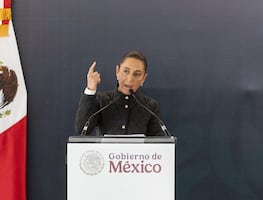Más Información

“Vamos a dar apoyo a los pequeños agricultores por sequía en Sonora”; Claudia Sheinbaum instruye a Berdegué

Derrota de México en disputa por maíz transgénico contra EU; estos son los argumentos de Sheinbaum y AMLO para prohibirlo

Óscar Rentería Schazarino, ha operado contra CJNG, Viagras y Templarios; es el nuevo secretario de Seguridad en Sinaloa

Claudia Sheinbaum pide respeto para Maru Campos; gobernadora anuncia acuerdo para transporte público

Claudia Sheinbaum anuncia los Centros de Cuidado Infantil en Chihuahua; inaugura hospital en Ciudad Juárez
The charm of Magical Towns has started to vanish due to the rising violence suffered by one out of each two towns appointed with the distinctive, as well as for the lack of budget from the federal government.
Created to support tourism in places with special attractions, the government program “Magical Towns” has been operating for 18 years and collects 121 communities currently, 10 of which were recently incorporated last October.
The other 111 received the appointment by the Tourism Ministry (Sectur) between 2001 and 2015; that is, they have been representing the brand from 4 to 18 years. However, these communities are not exempt from the violence wave in Mexico.
The Executive Secretariat of the National System of Public Security (SESNSP) registered 680 alleged victims of murder in the 111 Magical Towns during the first half of the year.
Half of these towns saw an increase in the number of alleged first-degree murders during the last three years after a total of 465 investigation files were opened for this crime during the first semester of 2016 .
Academics have said that there is insufficient information on Magical Towns regarding the number of tourists and the economical revenue they receive to evaluate the impact of violence in each locality.
With nine appointments each, the State of Mexico and Puebla are the entities with more Magical Towns in the country.
Six out of the nine
Magical Towns in the State of Mexico have experienced major violence in the last three years, according to data of the SESNSP.
Those towns are Tepotzotlán, Metepec, Aculco, Ixtapan de la Sal, Villa del Carbón, Teotihuacán and San Martín de las Pirámide s, where 49 pretrial investigations for homicide have been registered during the first half of 2019.
Aurora González
, minister of tourism of the State of Mexico , calculates that the entity receives around 17 million visitors yearly , out of which 6 million visit its nine Magical Towns. Valle de Bravo receives 2.3 million tourists, which makes it the town with more visitors in the entity, followed by Tepotzotlán , with 2.1 million , while Aculco and El Oro have between 300,000 and 400,000 visitors.
From the perspective of González, public security is essential for tourism , that is why she asserts to be in permanent coordination and communication with the different municipalities to monitor efforts and strategies that allow visitors to be safer.
“We are articulating efforts with the State of Mexico’s Public Security Ministry , although we cannot say that tourists are being attacked, but that it is a situation lived generally,” she exposed in an interview with EL UNIVERSAL .
She mentions that although the federal administration stopped supplying funds for the program this year, the state administration is investing budget on Magic Towns and other municipalities with tourist vocation.
González is evaluating to propose the incorporation of one more locality to the brand because they consider it has generated economic development in places like Tepotzotlán, which before receiving the distinctive in 2002 had only seven hotels and has 37 now.
Poverty is related
The specialist in tourism of the Ibero American University , Gerardo Herrera , says that violence in Magical Towns started to rise some years ago, a phenomenon that is related to the situation of poverty of their inhabitants.
Between 2010 and 2015, poverty increased in one out of each three communities added to the list of Magical Towns in 2012, according to the figures of the National Council for Evaluation of Social Development Policy (Coneval).
Poverty creates two phenomena: migration and insecurity , and because the first option became more complicated with Donald Trump’s presidency, the option for many inhabitants has been organized crime , and places that receive many tourists are ideal for it, explains the academic.
“If tourists perceive that a place is insecure , it doesn’t matter if you call it a Magical Town or Human Heritage, they will not want to visit it,” emphasizes Herrera.
From his perspective, the drastic reduction of funding from the federal government has affected the program.
“Historically, the Magical Towns program has been successful , but I think it is going through a crisis due to different circumstances, such as insecurity and poverty , but mainly because of the lack of support from the federal government, because it is an illusion to think that the denomination can support itself without any help,” he comments.
Besides, he explains that being a Magical Town does not solve poverty because it is not a mechanism of economic policy or a program to fight poverty, it is just a marketing tool to attract tourists to spend money.
“If poverty keeps increasing and the brand is not injected with funds, I’m afraid that violence in Magical Towns will increase and they will lose their charm in the future,” warns the expert from the Ibero.
Nine out of 10 Mexicans identify Magical Towns , one of the most famous three public brands, along with Pemex and the IMSS, according to the Mexican Institute for Intellectual Property (IMPI).
Vicente Fox
gave 27 recognitions during his administration; while Felipe Calderón gave 54 , and Enrique Peña Nieto gave 40 , 10 of which were given in 2018.
The head of Sectur, Miguel Torruco , said that this year the appointments for Magical Towns were suspended and new requests will be received until 2020 .
mp







